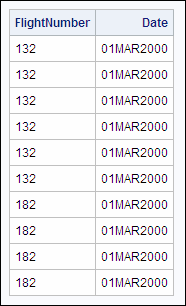Limiting the Number of Rows Displayed
Overview
When you create PROC SQL queries,
you sometimes find it useful to limit the number of rows that PROC
SQL displays in the output. To indicate the maximum number of rows
to be displayed, you can use the OUTOBS= option in the PROC SQL statement.
|
General form, PROC SQL
statement with OUTOBS= option:
PROC SQL OUTOBS= n;
n
specifies the number
of rows.
|
Note: The OUTOBS= option restricts
the rows that are displayed, but not the rows that are read. To restrict
the number of rows that PROC SQL takes as input from any single source,
use the INOBS= option. For more information about the INOBS= option,
see
Managing Processing Using PROC SQL.
Example
Suppose you want to
quickly review the types of values that are stored in a table, without
printing out all the rows. The following PROC SQL query selects data
from the table Sasuser.Flightschedule, which contains more than 200
rows. To print only the first 10 rows of output, you add the OUTOBS=
option to the PROC SQL statement.
When you limit the number
of rows that are displayed, a message similar to the following appears
in the SAS log.
Note: The OUTOBS= and INOBS= options
affect tables that are created by using the CREATE TABLE statement
and your report output.
Note: In many of the examples in
this chapter, OUTOBS= is used to limit the number of rows that are
displayed in output.
..................Content has been hidden....................
You can't read the all page of ebook, please click here login for view all page.

